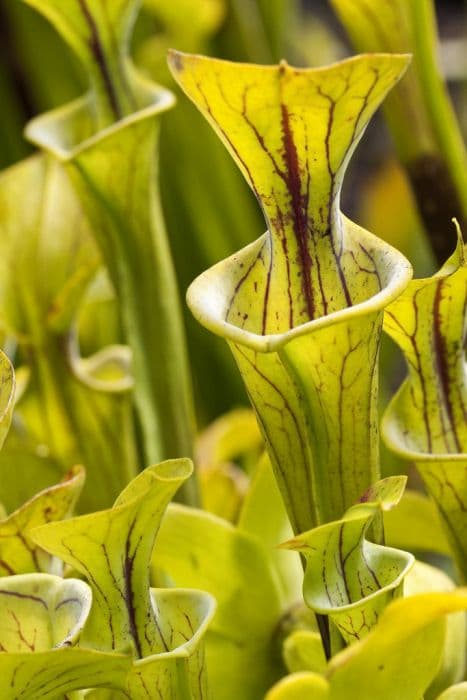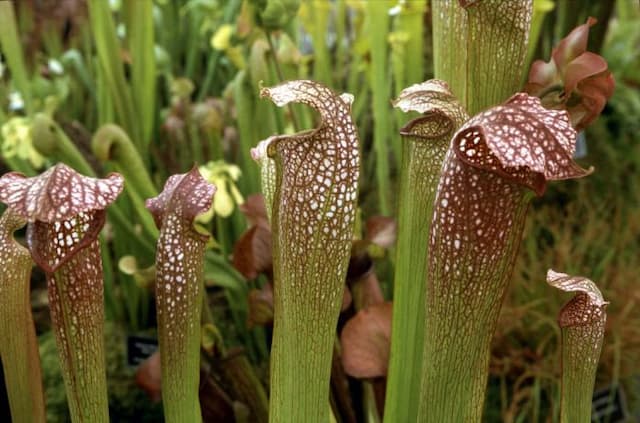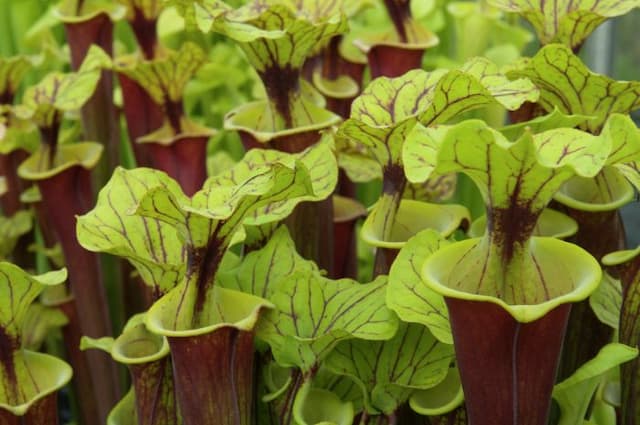Purple Pitcher Plant Sarracenia purpurea subsp. venosa

ABOUT
The pitcher plant displays a striking rosette of tubular leaves that are known for their bulbous and curvy shape with a flared, open end. These leaves are predominantly green but can exhibit tones of deep red or purple, especially beneath a full sun exposure. The color can be more pronounced within the veins that run throughout the leaves. The top of the leaves, known as the lid, is generally more modest in size compared to the sophisticated pitchers of other species. The surface of the leaves is smooth, and inside, there are downward-pointing hairs that help trap insects that are lured by the plant's nectar. In contrast to the green and purple of the leaves, the plant produces flowers that have a unique and complex structure. They stand out with their umbrella-like appearance, showcasing an array of colors that often feature deep reds, maroons, or even greenish hues. These flowers have a spiky look reminiscent of a gothic chandelier, contributing to the plant's exotic appeal. The bloom has a round, spherical central portion where the reproductive parts of the flower are housed, surrounded by several hanging, slender structures that add to its complexity and visual interest.
About this plant
 Names
NamesFamily
Sarraceniaceae
Synonyms
Purple Pitcher Plant, Southern Purple Pitcher Plant, Venous Pitcher Plant
Common names
Sarracenia purpurea var. venosa, Sarracenia venosa.
 Toxicity
ToxicityTo humans
The plant in question is known as the purple pitcher plant. It is not considered toxic to humans. There are no well-documented cases of poisoning or serious side effects from ingestion of this plant. However, as with any non-food plant, caution should be exercised and ingestion avoided, as individual sensitivities can vary, and it is generally not intended for human consumption.
To pets
The purple pitcher plant is not known to be toxic to pets. Similar to humans, there is no significant evidence to suggest that this plant poses a serious risk if ingested by pets such as dogs or cats. Nonetheless, pet owners should discourage their pets from eating non-food plants, including the purple pitcher plant, due to the possibility of gastrointestinal upset or an unexpected allergic reaction.
 Characteristics
CharacteristicsLife cycle
Perennials
Foliage type
Evergreen
Color of leaves
Green
Flower color
Red
Height
1-2 feet (30-60 cm)
Spread
1 foot (30 cm)
Plant type
Herb
Hardiness zones
3
Native area
North America
Benefits
 General Benefits
General Benefits- Ecological role - Sarracenia purpurea, commonly known as the Purple Pitcher Plant, plays a significant role in its native ecosystems by providing a unique microhabitat for various invertebrate species.
- Insect control - By feeding on insects, it helps to regulate the population of certain pest species and potentially reduce the need for chemical insecticides in nearby gardens and agricultural settings.
- Water management - The pitchers of the Purple Pitcher Plant collect rainwater, which can help to reduce soil erosion and manage excess surface runoff in its native habitat.
- Horticultural interest - With its distinctive pitchers and striking flowers, it is a popular ornamental plant that can add visual interest to gardens, particularly bog or water gardens.
- Conservation - As a native species, cultivating the Purple Pitcher Plant can contribute to biodiversity and the preservation of local flora and fauna.
- Educational value - It can be used as an educational tool to teach about carnivorous plants, their adaptations, and their role within their ecosystems.
- Wildlife support - It provides a source of nutrients for certain animals, for example, some species of bats have been known to drink nectar from its flowers.
 Medical Properties
Medical PropertiesThis plant is not used for medical purposes.
 Air-purifying Qualities
Air-purifying QualitiesThis plant is not specifically known for air purifying qualities.
 Other Uses
Other Uses- Sarracenia purpurea subsp. venosa, commonly known as the venus pitcher plant, can be used as a decorative feature in terrariums or bog gardens due to its unique appearance and insect-trapping mechanism.
- The plant's pitchers are sometimes used in floral arrangements to add an exotic or whimsical touch, especially around Halloween for its eerie look.
- Fine art photographers and artists may use the venus pitcher plant as an intriguing subject due to its striking form and vibrant colors.
- Enthusiasts of carnivorous plants cultivate it as a hobby plant, often engaging in the propagation and breeding of various hybrids and cultivars.
- Some educational programs use the venus pitcher plant to teach about unique plant adaptations, especially in environments like bogs or wetlands.
- Insect enthusiasts sometimes utilize Sarracenia purpurea subsp. venosa to observe the lifecycle of insects that are attracted to the plant, including their capture and digestion.
- Conservationists may plant Sarracenia purpurea subsp. venosa in habitat restoration projects to reintroduce native flora and to maintain ecological balance in wetland areas.
- The plant has been used in craft projects, such as making prints or patterns from the shape and structure of its pitchers, due to their unique and recognizable form.
- Some gardeners use the venus pitcher plant as a method of organic pest control, leveraging its natural insect-trapping abilities to reduce unwanted pest populations.
- It is occasionally referenced in pop culture, such as in literature and video games, where carnivorous plants are depicted with various degrees of creative license.
Interesting Facts
 Feng Shui
Feng ShuiThe Purple Pitcher Plant is not used in Feng Shui practice.
 Zodiac Sign Compitability
Zodiac Sign CompitabilityThe Purple Pitcher Plant is not used in astrology practice.
 Plant Symbolism
Plant Symbolism- Uniqueness: The Venus flytrap's (Sarracenia purpurea subsp. venosa) distinctive appearance and fly-catching mechanism symbolize uniqueness and individuality.
- Ingenuity: Its intricate method of trapping insects reflects cleverness and resourcefulness.
- Patience: The plant's waiting strategy for capturing prey signifies patience and the ability to seize opportunities at the right moment.
- Adaptation: As a carnivorous plant living in nutrient-poor environments, it epitomizes adaptation and surviving against the odds.
- Balance: Venus flytraps balance the ecosystem by controlling insect populations, representing harmony and ecological balance.
 Water
WaterThe Purple Pitcher Plant requires consistent moisture and should be watered regularly, keeping the soil consistently damp but not waterlogged. This carnivorous plant thrives in a bog-like environment and is best watered using the tray method, where water is added to a saucer or tray beneath the pot, allowing the roots to absorb moisture from the bottom. Typically, provide about an inch of water per week, but this can vary depending on temperature and humidity; during hot, dry spells, watering may be needed more frequently.
 Light
LightThe Purple Pitcher Plant prefers full sun to partial shade, thriving on at least six hours of direct sunlight per day. Place the plant in a location where it can receive a good amount of morning sunlight, which is less intense than the afternoon sun, but it can also handle brighter conditions if acclimated properly.
 Temperature
TemperatureThe Purple Pitcher Plant is hardy and can tolerate a temperature range from 20°F to 90°F, but it does best when the temperature is between 70°F and 85°F during its growing season. It is important to note that this plant can withstand light frosts and benefits from the colder temperatures in winter for its required dormancy period, as long as the roots do not freeze completely.
 Pruning
PruningPruning the Purple Pitcher Plant is necessary to remove dead or damaged pitchers and to encourage new growth. It's best to prune in early spring before new growth starts. Cut away any spent pitchers and leaves from the previous year to keep the plant looking tidy and to prevent potential disease or pest issues. Pruning should be done as needed, usually once a year.
 Cleaning
CleaningAs needed
 Soil
SoilThe Venus Flytrap, which is a common name for Sarracenia purpurea subsp. venosa, thrives best in a soil mix made of 1 part peat moss to 1 part perlite or sand to ensure good drainage and aeration. The soil pH should be acidic, around 4.0 to 6.0.
 Repotting
RepottingVenus Flytraps should be repotted every 2 to 3 years to refresh the soil and accommodate growth, ideally in the spring just before the growing season begins.
 Humidity & Misting
Humidity & MistingVenus Flytraps prefer high humidity levels, around 50-70%, which is crucial for their health and proper functioning of the trap mechanisms.
 Suitable locations
Suitable locationsIndoor
Place in bright, indirect light with high humidity.
Outdoor
Ensure full sun, moist soil, and protect from frost.
Hardiness zone
5-8 USDA.
 Life cycle
Life cycleThe Sarracenia purpurea subsp. venosa, commonly known as the purple pitcher plant, begins its life cycle with seed germination, which requires cold stratification and typically occurs in the wet, acidic soils of its native habitat. After germination, the seedling develops a rosette of pitcher-shaped leaves specialized for trapping insects; these continue to grow as the plant matures. The plant reaches full maturity in several years and produces flowers with purple petals on a tall scape once per year, usually in late spring. Following pollination by insects, which are attracted to the flowers and not usually captured, the plant sets capsule-like seed pods that ripen and release numerous small, black seeds. These seeds endure a dormancy period before the next growing season when they can germinate to begin the cycle anew. Throughout its lifetime, which can span multiple years, the purple pitcher plant undergoes periods of active growth in spring and summer, followed by dormancy in winter conditions.
 Propogation
PropogationPropogation time
Spring to Summer
The most popular method of propagating the Purple Pitcher Plant, Sarracenia purpurea subsp. venosa, is through division, which is best done in late winter to early spring before new growth begins. To propagate by division, carefully remove the plant from its pot and gently separate the rhizomes, ensuring each division has at least one growth point. Trim any dead or excessive roots and replant the divisions into pots filled with a suitable carnivorous plant mix, such as a combination of peat and perlite. Water the new plants thoroughly, using distilled or rainwater, until they are established. Divisions allow the Purple Pitcher Plant to retain its parent characteristics and typically ensures a high success rate.









